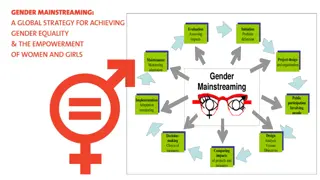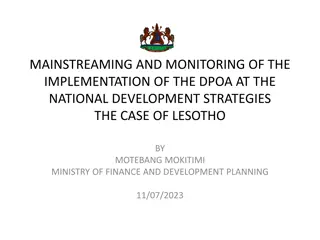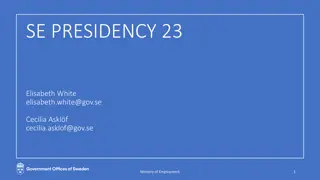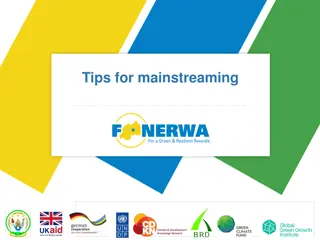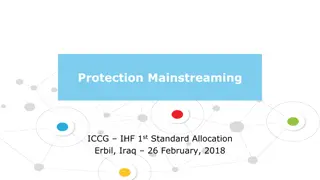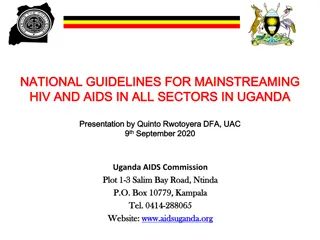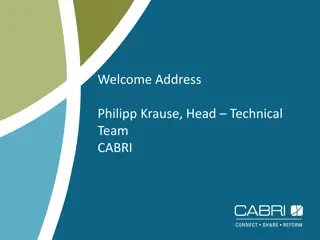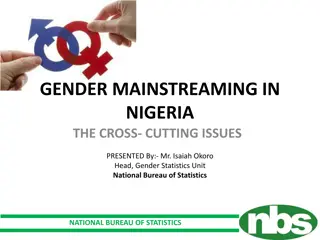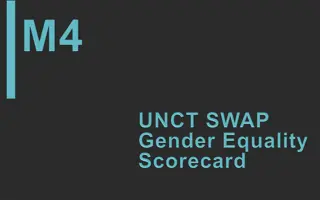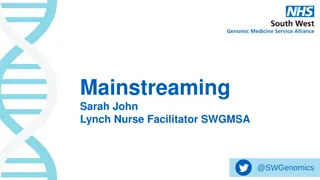Gender Mainstreaming in UNSDCF Cycle
In the UNSDCF cycle, entry points for gender mainstreaming involve actions to integrate gender into national plans, frameworks, and joint work plans. Utilize resources, including the UNCT SWAP Gender Equality Scorecard, for a gender-responsive engagement. Ensure gender expertise, identify priorities for gender equality, and develop outcomes addressing gender inequality. Track progress using sex-disaggregated data and align with SDG targets for gender equality empowerment.
Download Presentation

Please find below an Image/Link to download the presentation.
The content on the website is provided AS IS for your information and personal use only. It may not be sold, licensed, or shared on other websites without obtaining consent from the author.If you encounter any issues during the download, it is possible that the publisher has removed the file from their server.
You are allowed to download the files provided on this website for personal or commercial use, subject to the condition that they are used lawfully. All files are the property of their respective owners.
The content on the website is provided AS IS for your information and personal use only. It may not be sold, licensed, or shared on other websites without obtaining consent from the author.
E N D
Presentation Transcript
Module Objectives Identify the entry points for gender mainstreaming in the UNSDCF cycle and actions to be taken; Draw on all the resources presented and leverage on the momentum for the integration of gender in their context; Harness the potential of the UNCT SWAP Gender Equality Scorecard to ensure a gender-responsive UNSDCF engagement; Directly apply the inputs and considerations made during the training when developing the UNSDCF M4|GEWE in the development phase
Gender-responsive UNSDCF Implementation Results Analysis Development of the Cooperation Framework Gender analysis of key national development plans Gender Equality Profile (sex disaggregated data and analysis) Conflict analysis (as appropriate) Inclusive participation of CSO (LNOB) Gender mainstreaming in joint work plans and joint programmes Funding Framework and SDG Financing Strategy UN Women collaborative advantage and gender expertise Mainstreaming Gender in ToC, CF outcomes/outp uts/indicators Agency Specific- Documents UNCT SWAP Score Card Feedback Loop into new cycle BPFA+25 national reports Thematic KP, research reports, qualitative data, etc. Flagship reports (Progress, etc.) Regular follow up on the management response to evaluation Guidance and expertise on gender sensitive evaluation and management response M4|GEWE in the development phase
Entry Points UNSDCF Process GEWE Actions Common Country Analysis Gender Analysis Engender the Theory of Change Theory of Change Gender-responsive Outputs, Outcomes, Indicators UNSCF Development Results Programme on Gender M4|GEWE in the development phase
Minimum requirements Ensure gender expertise during the development of the cooperation framework. Identify priorities on gender equality and the empowerment of women and girls, and integrate them into national development plans, legislation and frameworks. Apply a multiple-track strategy for gender mainstreaming with dedicated outcomes, targets and indicators designed to address gender inequality. [indicator 1.3 UNCT-SWAP Gender Equality Scorecard] Reflect gender-based and intersectoral forms of discrimination in the development of outcomes and outputs. Ensure at least one gender-targeted outcome, and the integration of gender-equality considerations into all outcomes. [indicator 1.2 UNCT-SWAP Gender Equality Scorecard] Ensure disaggregation of Indicators by sex and age; and that 33 percent of the indicators measure changes in gender equality and women s empowerment, in line with SDG targets, including SDG 5. [indicator 1.3 UNCT-SWAP Gender Equality Scorecard] M4|GEWE in the development phase
INTERSECTIONALITY M4|GEWE in the development phase
Gender-responsive Results-Based Management Gender-responsive RBM makes sure gender equality is a key component of the process of achieving the desired result. A gender-responsive results chain is a coherent sequence of elements (each of which has a different function in the result chain) to improve gender equality. Results-based and gender-responsive management provides a clear vision of the desired impacts of our programme on gender equality. M4|GEWE in the development phase
The Results Chain institutions or people do a) something differently (behavioural change) or b) something better (change in performance) influence, but largely beyond the control of the programme actions taken to transform inputs into outputs timeframe: during or up to a few years after programme HIGH LEVEL OF CONTROL LOW LEVEL OF CONTROL RESULTS INPUTS OUTPUTS OUTCOME IMPACT ACTIVITIES a group of people or an organization has improved capacities, abilities, skills, systems, or if something is built, created or repaired as a direct result of the programme long-term effects of a programme resources needed to carry out activities broader than the programme; programme only contributes to it are under the control of your organization and its partners timeframe: typically 2- 5 years after programme ends M4|GEWE in the development phase timeframe: during programme
Applying a gender lens Definition Gender questions Highest order objective, it represents the longer-term change that the intervention intends to contribute to. Is gender equality one of the overall objectives the intervention aims to contribute to? Are women and men of different ages and diverse background going to benefit equally from the longer- term change? Impact Describes the short and medium- term effects of the intervention. Does the outcome include any clear reference to men and women, boys and girls, of various background and existing inequalities between them? Does the intervention have the potential to improve women s access to resources, services, technologies, training and employment opportunities? Outcome M4|GEWE in the development phase
Applying a gender lens Definition Gender questions Outputs describe what the intervention intends to deliver in order to achieve the Outcome. These are the results that the intervention must deliver. Do the outputs respond to the different needs and priorities of men and women (across age and background), as identified by the gender analysis? Do the outputs challenge/redress existing gender inequalities and discriminatory norms and practices? Outputs Activities describe what actions will be undertaken to achieve each output. Are women and men provided with equal opportunities to plan, participate and monitor the project s activities? Do the planned activities take into account the roles and responsibilities of women and men, in order to ensure equal opportunities for and benefits from participation? Activities The Impact and Outcome statements might not need to mention gender explicitly, but the gender equality dimensions must be reflected in indicators, baselines, targets, means of verifications, assumptions and risks; On the other hand, Outputs and Activities need to be specific and clarify how the project intends to respond to women and men s different needs, priorities and constraints identified M4|GEWE in the development phase
Group Exercise ctd. Go back to your original grouping, i.e. political, social, economic, justice and violence, environmental Based on the gender analysis and the work done for engendering the theory of change, formulate: Two outcomes, with at last one gender-specific and the other reflecting gender considerations Two outputs One activity per output M4|GEWE in the development phase
Some examples of gender-responsive outcomes Outcome 1: By 2024, vulnerable populations, including women, children, adolescents and youth, have more equitable access to quality basic social services, according to their age and gender-specific needs, including in humanitarian situations (UN Women Mali) M4|GEWE in the development phase
Credit: Un Women, Turning Promises into Actions M4|GEWE in the development phase
Questions? Photo credit: www.flickr.com M4|GEWE in the development phase



